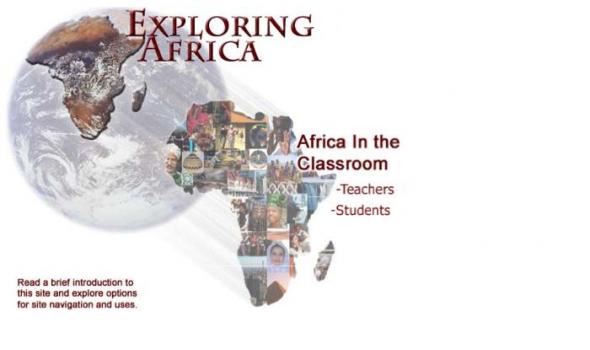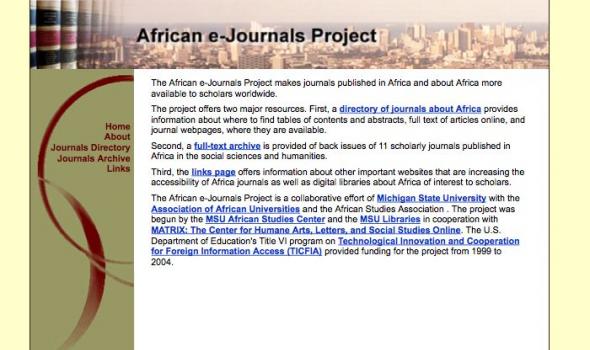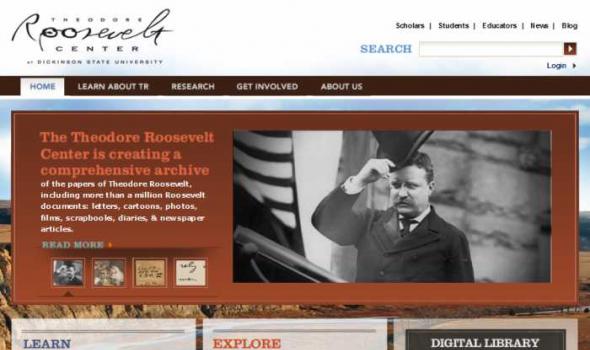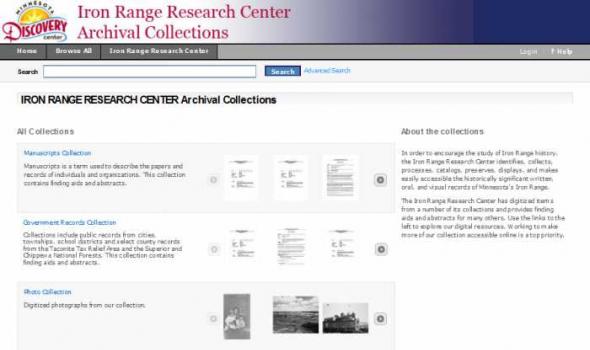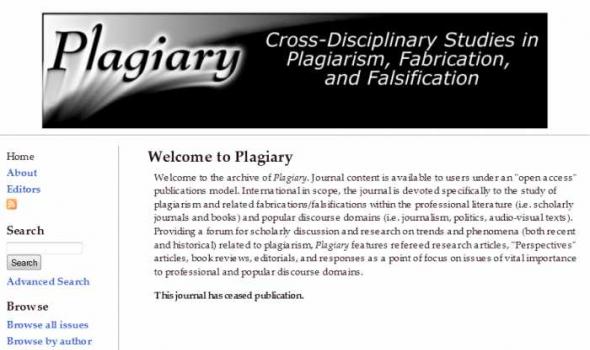Category: Social Sciences
Results
In 2002 the African Media Program offers an on-line comprehensive reference guide to approximately 10,000 films, videos, and other audiovisual materials concerning Africa (both Sub-Saharan and North Africa). It includes film and video productions made in Africa and around the world. This new database incorporates and updates material contained in the 1982 print compendium, adds many new reviews, and provides as complete a citation as possible from a wide variety of sources.
Africa Past and Present is a podcast about history, culture, and politics in Africa and the diaspora. The show highlights interesting and significant people, ideas, and discussions in African Studies from a wide range of disciplines and perspectives. Our mission is to broaden the availability and accessibility of cutting-edge knowledge relating to African experiences and to do so in a down-to-earth and informed manner. Shows feature interviews with eminent scholars and persons, commentary on current events, and issues and debates of relevance to Africans at home and abroad.
Ajami is the centuries-old practice of using modified Arabic scripts to write non-Arabic languages. It comes from the Arabic word for foreigner or non-Arab and is used widely throughout West Africa for both religious and secular writings.
Ajami in the Senegambia makes accessible over 20 handwritten ajami manuscripts produced by West African scholars. The texts contain insightful discussions on mutual understanding between people of different faiths, races and ethnic backgrounds in Senegambia. They capture several Senegambian Muslim scholars' views on peaceful cohabitation, moderation and non-violence that have been a prominent feature of Senegambian communities.
The Exploring Africa! curriculum is divided into Units, Modules, and Learning Activities. Each unit covers a major topic or theme in the study of Africa. Each unit is divided into thematic, disciplinary, regional, or country modules. Each module is comprised of four to eight learning activities. The learning activities in each module vary in length of time needed for completion. Consequently, each module will take between two and five standard 50-minute class periods to complete. Teachers are free to select one or two learning activities from a module or to complete all of the learning activities.
The African e-Journals Project makes journals published in Africa and about Africa more available to scholars worldwide.
The project offers two major resources. First, a directory of journals about Africa provides information about where to find tables of contents and abstracts, full text of articles online, and journal webpages, where they are available.
Second, a full-text archive is provided of back issues of 11 scholarly journals published in Africa in the social sciences and humanities.
The South Africa Film and Video Project (SAFVP) assists in preserving and making accessible moving images from the years of struggle against apartheid. This project aims to safeguard memories of this important political movement and to inspire citizens of South Africa and the world to promote justice and reconciliation in our own time. In addition to on-line streaming of the productions, copies of some materials are being made available through the MSU Libraries.
The African Activist Archive is preserving and making available online the records of activism in the United States to support the struggles of African peoples against colonialism, apartheid, and social injustice from the 1950s through the 1990s. The website includes:
growing online archive of historical materials - pamphlets, newsletters, leaflets, buttons, posters, T-shirts, photographs, and audio and video recordings
personal remembrances and interviews with activists
an international directory of collections deposited in libraries and archives
Feature Video The CVET archive is a unique, publicly accessible video record of the peak of popular resistance against apartheid. Browse Genres February 13, 1990 This project is supported by the South African Film and Video Project .
About Overcoming Apartheid and Michigan State University This educational website provides primary source materials, newly-written narrative, and curriculum ideas for teaching high school and undergraduate students about the many generations who struggled to end apartheid and build democracy in South Africa. Interviews with more than 60 people bring this history alive. Many important oral history projects are being undertaken in South Africa, but few are online. This website’s 40 hours of interviews – and 120 segments created from them – are a unique historical resource for anyone who cares about people determined to become free from oppression.
Filipino Workers in Hawaii, 1926 FILIPINO WORKERS IN HAWAII, 1926 Photographs taken by Lt. Colonel Duckworth-Ford on an assignment to Hawaii regarding the labor conditions of Filipino laborers in Hawaii; they are described by Duckworth-Ford. The photographs show Filipino laborers and their relatives, fields and lands, water sources, plantation buildings, laborer housing and schools, store, hospital facility, labor officials. Also sugar cane planting and harvesting, cane processing equipment, cane transport.
The Douglas Oliver Collection WELCOME TO THE DOUGLAS OLIVER COLLECTION. Douglas Oliver (Feb. 10, 1913 - October 30, 2009) completed a B.A. at Harvard in 1934 and and a DPhil in Ethnology at the University of Vienna in 1935. Between 1936 and 1941, he was a research associate on the staff of Harvard's Peabody Museum of Ethnology and Archaeology. Between 1938 and 1939, Oliver conducted research on Bougainville, among the Siwai (a.k.a. Siuai) people. The majority of these images derive from that period, and were donated to the Pacific Collection following Dr. Oliver's death in 2009. Image Courtesy Wikimedia Commons Related Information : Association for Social Anthropology in Oceania, Winter 1990 "Douglas L. Oliver, 1913-2009"
Dakin Fire Insurance Maps WELCOME TO DAKIN FIRE INSURANCE MAPS. Welcome to Digitized Dakin Fire Insurance Maps The production of fire insurance plans of North American cities was dominated by two companies, the Sanborn Map Company of New York and the Charles E. Goad Company of London. The stories of other publishers, for the most part, have not been adequately told. The West, includ[ing] Hawaii, had a number of individuals and institutions which produced insurance plans. One of the more successful of them was the Dakin Publishing Company of San Francisco. Dakin was in existence from about 1885 until the early 1960's, and actively produced insurance maps from its beginning until the second decade of the 20th Century. * * Hoehn, R.
Within the vast body of literature on Asia held by the Asia Collection at the University of Hawaii are fascinating illustrations of the people of Asia and the environment in which they live. These images are a visual record of the lives of the people and their surroundings. The sheer number of illustrations makes digitizing all of them an impossible task, so we have decided to concentrate on the theme "Asia at Work." Work is the activity by which so many of us identify ourselves. The tools we use, the human interaction and cooperation that occurs in the course of its performance, and the skills we employ all, to a great extent, help define who we are. Images are arranged by country.
The Valley Project details life in two American communities, one Northern and one Southern, from the time of John Brown's Raid through the era of reconstruction. In this digital archive you may explore thousands of original letters and diaries, newspapers and speeches, census and church records, left by men and women in Augusta County, Virginia, and Franklin County, Pennsylvania. Giving voice to hundreds of individual people, the Valley Project tells forgotten stories of life during the era of the civil war.
My Collections DIGITAL LIBRARY The Theodore Roosevelt Digital Library includes letters to and from Roosevelt, diary entries, notes, political cartoons, scrapbooks, and more. Timeline Explore the timelines for important dates in TR’s personal and political life, military career, publications, hunting and exploration trips, as well as his time in Dakota Territory. About Us News Explore digital updates, articles and upcoming events. Mission Our goal here at the Theodore Roosevelt Center is to raise the profile of Theodore Roosevelt and to preserve his legacy through events, publications, and the creation of a comprehensive digital presidential library that is freely accessible worldwide via the internet.
The Art of Daily Life There is no equivalent in the many Native American languages for the word art . Yet the objects here suggest that Native Americans are a highly spiritual people who create objects of extraordinary beauty. In Native American thought there is also no distinction between what is beautiful or functional, and what is sacred or secular. Design goes far beyond concerns of function, and beauty is much more than simple appearances. For many native peoples, beauty arises from living in harmony with the order of the universe.The concerns and aspirations of a vital contemporary American Indian population changes as the world changes.
The Institute's collection of Asian art represents seventeen Asian cultures spanning over 5,000 years. The Department of Asian Arts has benefited greatly from generous gifts from knowledgeable collectors. Augustus L. Searle, Alfred F. Pillsbury, Richard P. Gale, Louis W. Hill, Jr., and Ruth and Bruce Dayton have donated specialized collections of international reputation, including ancient Chinese bronzes, ancient and post-Sung jade, Chinese monochrome ceramics, Ukiyo-e paintings, Japanese prints, and classical Chinese furniture. In addition, highly regarded specialized collections of Ch'ing dynasty silk textiles, Miao textiles, and surimono prints have been built over the years. The curatorial department's goal is to provide the public with a broad overview of Asian art.
IRON RANGE RESEARCH CENTER Archival Collections All Collections About the collections In order to encourage the study of Iron Range history, the Iron Range Research Center identifies, collects, processes, catalogs, preserves, displays, and makes easily accessible the historically significant written, oral, and visual records of Minnesota’s Iron Range. The Iron Range Research Center has digitized items from a number of its collections and provides finding aids and abstracts for many others. Use the links to the left to explore our digital resources. Working to make more of our collection accessible online is a top priority.
The College of Saint Benedict Archives collects the historical records of the College, 1961 to present. Vivarium includes photos, maps, and scans of publications and documents, with more to come. In addition to materials found here, see also the CSB Digital Archives Page Search for Text: For a general search of the collection by keyword, simply type a word or words in the box below. Do not add Boolean operators between words; the "and" is automatically used by the search engine. Search by Exact Phrase: Use this search box for searching the transcripts for names, titles, and other exact phrases. ...Or Browse Some of Its Parts: Alumnae publications : The Handshake , CSB Alumnae Magazine Feb.
Minnesota Reflections Minnesota Reflections All Collections The American Swedish Institute, a historic museum dedicated to the celebration of Swedish culture, is home to collections on the history of Swedish immigration to the United States, particularly immigration to Minnesota, Swedish-American life and culture and the history and culture of Sweden as it has influenced Swedish America. The... more... The Amherst H. Wilder Foundation is a non-profit health and human services organization founded by a philanthropic Saint Paul businessman, Amherst H. Wilder and his family. For more than 100 years, Wilder has combined direct service, research, and community development to address the needs of the most vulnerable people in greater Saint... more...
About New York Heritage is a project of the NY 3Rs Association, Inc. New York Heritage is a project of the NY 3Rs Association, Inc. New York Heritage is a research portal for students, educators, historians, genealogists, and anyone else who is interested in learning more about the people, places and institutions of New York State. The site provides free access to more than 170 distinct digital collections, totalling hundreds of thousands of items. The collections in New York Heritage represent a broad range of historical, scholarly, and cultural materials held in libraries, museums, and archives throughout the state. Collection items include photographs, letters, diaries, directories, maps, newspapers, books, and more.



